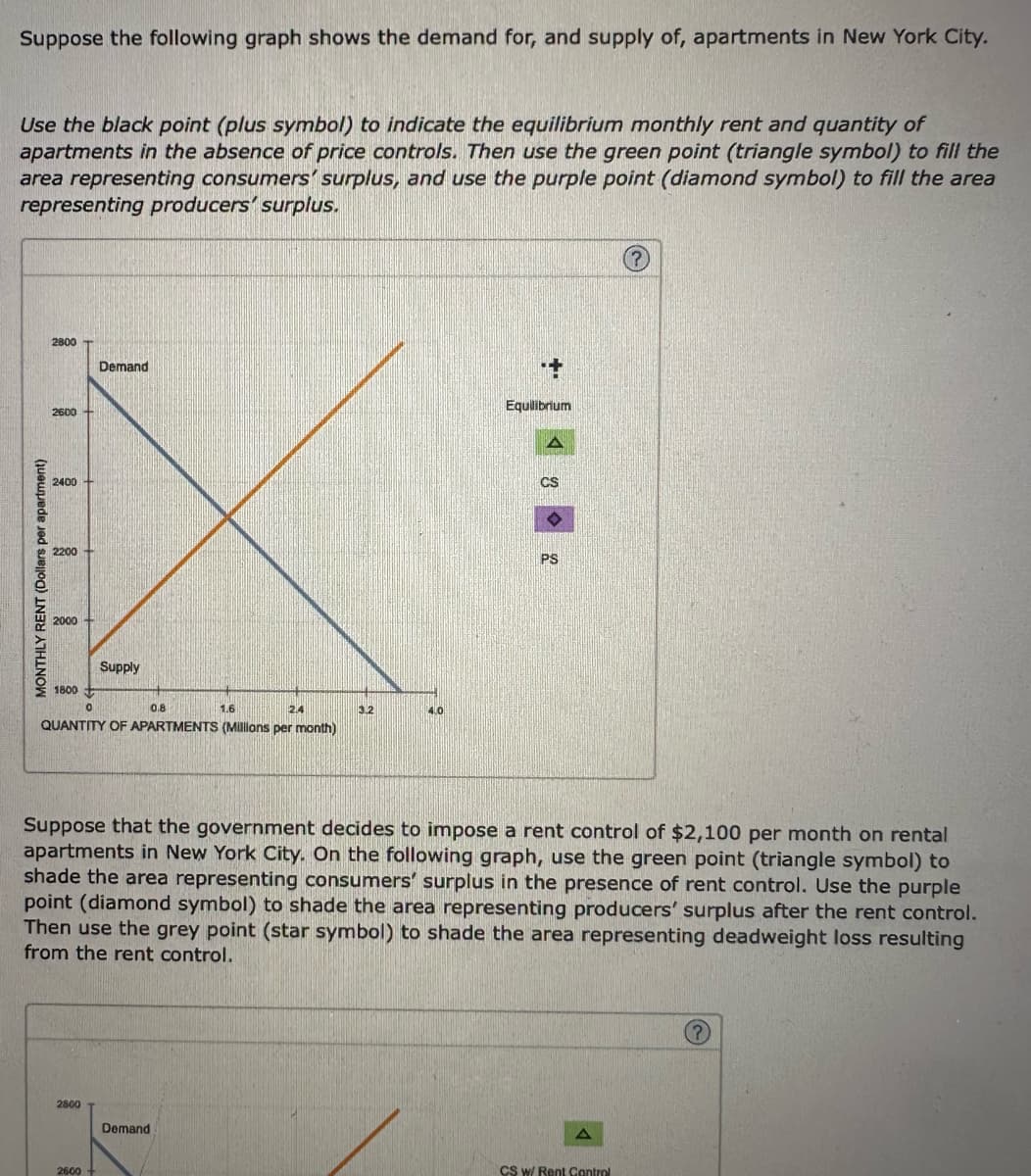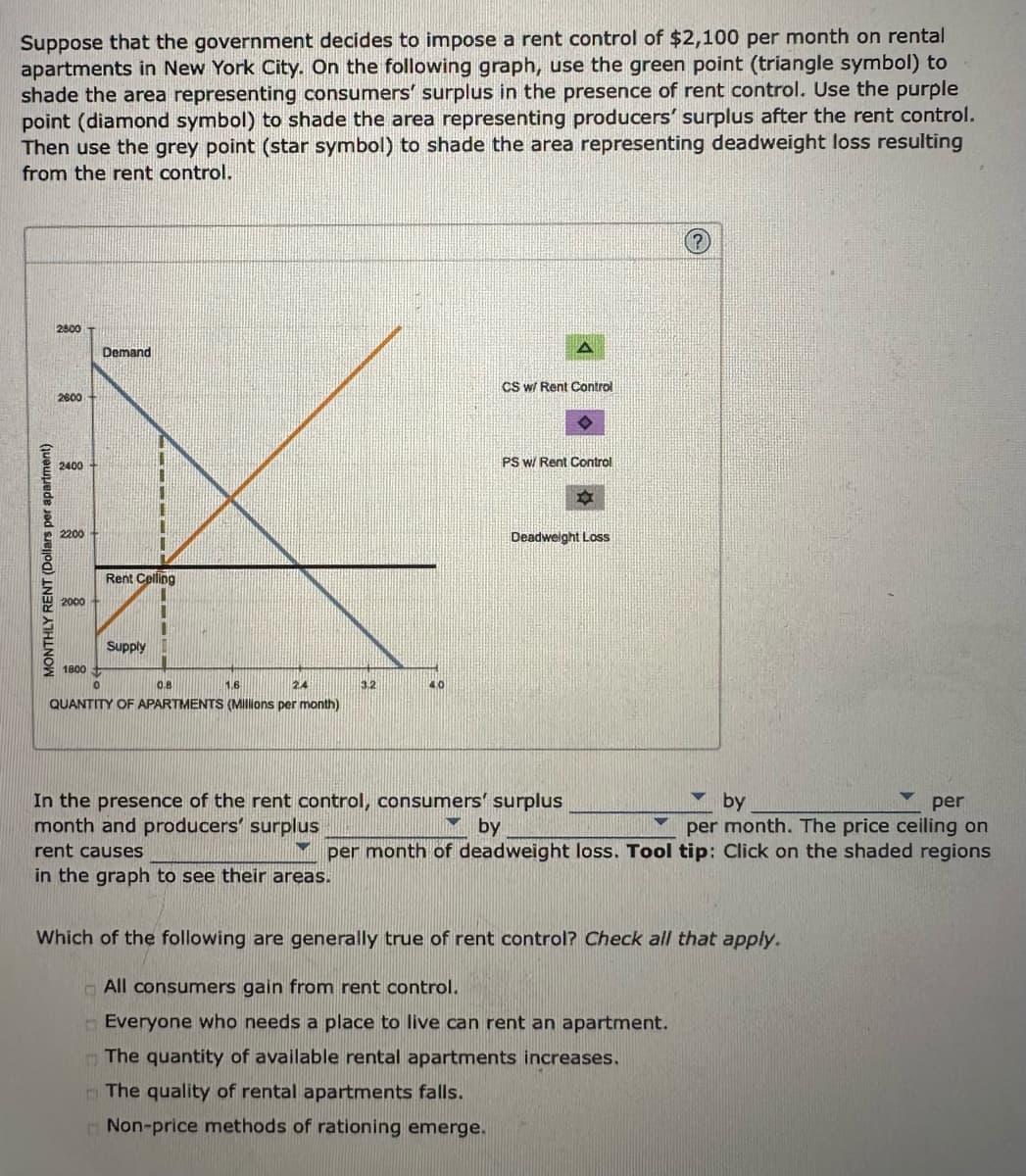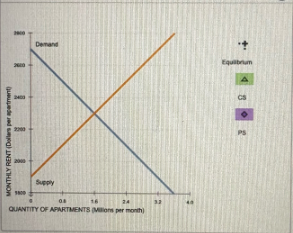Suppose the following graph shows the demand for, and supply of, apartments in New York City. Use the black point (plus symbol) to indicate the equilibrium monthly rent and quantity of apartments in the absence of price controls. Then use the green point (triangle symbol) to fill the area representing consumers' surplus, and use the purple point (diamond symbol) to fill the area
Suppose the following graph shows the demand for, and supply of, apartments in New York City. Use the black point (plus symbol) to indicate the equilibrium monthly rent and quantity of apartments in the absence of price controls. Then use the green point (triangle symbol) to fill the area representing consumers' surplus, and use the purple point (diamond symbol) to fill the area
Chapter7: Market Efficiency And Welfare
Section: Chapter Questions
Problem 5P
Related questions
Question
Confused on how to solve this set of problems

Transcribed Image Text:Suppose the following graph shows the demand for, and supply of, apartments in New York City.
Use the black point (plus symbol) to indicate the equilibrium monthly rent and quantity of
apartments in the absence of price controls. Then use the green point (triangle symbol) to fill the
area representing consumers' surplus, and use the purple point (diamond symbol) to fill the area
representing producers' surplus.
MONTHLY RENT (Dollars per apartment)
2800
2600
2400
2200
2000
1800
Demand
0
0.8
2.4
QUANTITY OF APARTMENTS (Millions per month)
2800 T
Supply
2600+
1.6
Demand
3.2
4.0
+
Equilibrium
Suppose that the government decides to impose a rent control of $2,100 per month on rental
apartments in New York City. On the following graph, use the green point (triangle symbol) to
shade the area representing consumers' surplus in the presence of rent control. Use the purple
point (diamond symbol) to shade the area representing producers' surplus after the rent control.
Then use the grey point (star symbol) to shade the area representing deadweight loss resulting
from the rent control.
A
PS
CS w/ Rent Control

Transcribed Image Text:Suppose that the government decides to impose a rent control of $2,100 per month on rental
apartments in New York City. On the following graph, use the green point (triangle symbol) to
shade the area representing consumers' surplus in the presence of rent control. Use the purple
point (diamond symbol) to shade the area representing producers' surplus after the rent control.
Then use the grey point (star symbol) to shade the area representing deadweight loss resulting
from the rent control.
MONTHLY RENT (Dollars per apartment)
2800
2600
2400
2200
2000
1800
Demand
Rent Celling
Supply
11
0
1.6
24
QUANTITY OF APARTMENTS (Millions per month)
0.8
3.2
4.0
CS w/ Rent Control
PS w/ Rent Control
➡
Deadweight Loss
Ⓒ
by
per
M
by
In the presence of the rent control, consumers' surplus
month and producers' surplus
per month. The price ceiling on
rent causes
per month of deadweight loss. Tool tip: Click on the shaded regions
in the graph to see their areas.
Y
♥
Which of the following are generally true of rent control? Check all that apply.
All consumers gain from rent control.
Everyone who needs a place to live can rent an apartment.
The quantity of available rental apartments increases.
The quality of rental apartments falls.
Non-price methods of rationing emerge.
Expert Solution
Step 1
Rent control, also known as rent regulation, is a set of laws or regulations that limit the amount landlords can charge for rental properties.
Given graph

Trending now
This is a popular solution!
Step by step
Solved in 3 steps with 4 images

Knowledge Booster
Learn more about
Need a deep-dive on the concept behind this application? Look no further. Learn more about this topic, economics and related others by exploring similar questions and additional content below.Recommended textbooks for you

Exploring Economics
Economics
ISBN:
9781544336329
Author:
Robert L. Sexton
Publisher:
SAGE Publications, Inc


Exploring Economics
Economics
ISBN:
9781544336329
Author:
Robert L. Sexton
Publisher:
SAGE Publications, Inc
